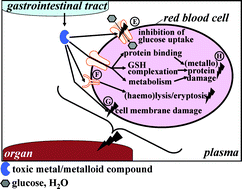Probing bioinorganic chemistry processes in the bloodstream to gain new insights into the origin of human diseases
Abstract
In the context of elucidating the origin of human diseases, past poisoning epidemics have revealed that exceedingly small doses of inorganic environmental pollutants can result in dramatic effects on human health. Today, numerous organic and inorganic pollutants have been quantified in human blood, but the interpretation of these concentrations remains—from a public health point of view—problematic. Conversely, the biomolecular origin for several grievous human diseases is essentially unknown. Taken together and viewed in the context of recent bioinorganic research findings, the established human blood concentrations of toxic metals and metalloids may be functionally connected with the etiology of specific human diseases. To unravel the underlying biomolecular mechanisms, and taking into account the basic flow of dietary matter through mammalian organisms, a better understanding of the bioinorganic chemistry of toxic metals and metalloid compounds in the bloodstream is emerging as a promising avenue for future research. To this end, the concerted application of modern proteomic methodologies,

- This article is part of the themed collection: New Talent: Inspiration for the future

 Please wait while we load your content...
Please wait while we load your content...